


M113 Trägerfahrzeug RATAC ABRA (Artillerie Beobachtungs Radar Anlage)
English Transaltion
Merci à Thomas Hartwig pour les photographies
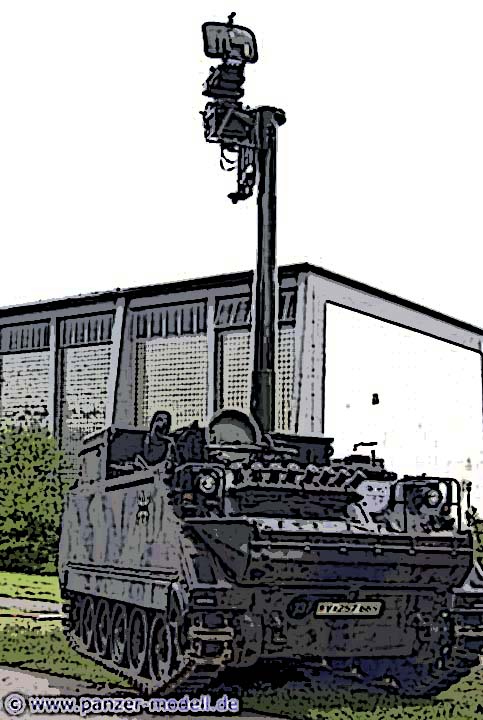 |
À la fin des années 50, le M113 américain a été commandé et 1600 ont été mis en service dans la Bundeswehr en 1962
Le M113 est fabriqué en métal léger Tous les écoutilles et les portes sont protégées contre les infiltration d’eau. Initialement prévu pour flotter, le M113, après divers chantiers de remise à niveau a perdu sa capacité amphibie
En 1963/64, certains M113 reçoivent de nouveaux équipements, y compris le système d'éclairage, de nouveaux équipements de radio, les phares anti brouillard rangements et inscriptions en allemand sur ou dans le véhicule. Avec cette mise à jour, le M113 devient le , M113 G.
En 1974-1981, les M113 se sont progressivement convertis au diesel et reçoivent la désignation M113 A1 GE.
Dans les années 80, certains des moteurs diesel ont été convertis avec une Saugkühlanlage (augmentation ou de refroidissement sous pression dans le moteur) ce qui entraine le montage d’un échappement sur le toit
Avec d'autres petites améliorations, ces véhicules, prennent la désignation M113 A2 GE.
De plus, à la fin des années 80, certains véhicules reçoivent un réservoir de carburant extérieur (EFT external fuel tank), avec un volume de 360 litres ce qui libère du volume dans le compartiment de combat .
Mais avec 12,5 tonnes le M 113 est dangereux à conduire (défauts dans la conduite et le freinage)
Ils ont été remis à niveau avec un meilleur système de freinage et une nouvelle direction, un nouveau moteur diesel MTU de 300 chevaux.
Ces versions reçoivent la désignation de M113 G3 EFT GE.
Le véhicule Ratac ABRA (Artillerie Beobachtungs Radar Anlage observation radar ou d'artillerie) est utilisé pour le repérage des positions d'artillerie ennemie, et la surveillance du champ de bataille De 1976 à 1978, la Bundeswehr reçoit 62 véhicules Ratac Ce système dispose d'un mât télescopique 6m de long et le radar a une portée de 20 km. pour les véhicules, 12 kms pour les personnes et pour les projectiles de calibre 105 mm et 155 mm 12 ou 18 km.
Les données d'observation obtenues viennent en aide de l'artillerie pour tirer sr des objectifs
Ils sont déployés dans les bataillons d'artillerie
Le poids du véhicule est de 13 tonnes avec une autonomie d'environ 300 km
| Camouflage NATO Bronze Green (RAL 6031) Teerschwarz (RAL 9021) and Leather brown (RAL 8027( Internet) |
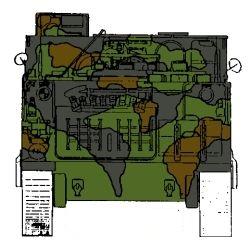 |
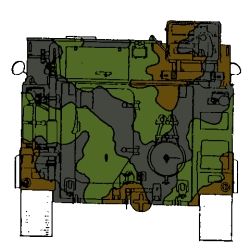 |
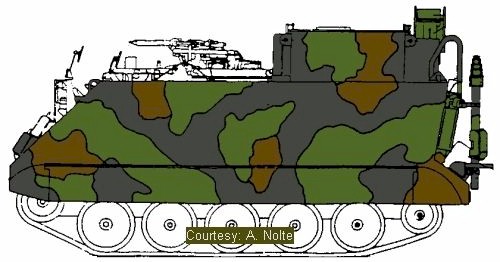 |
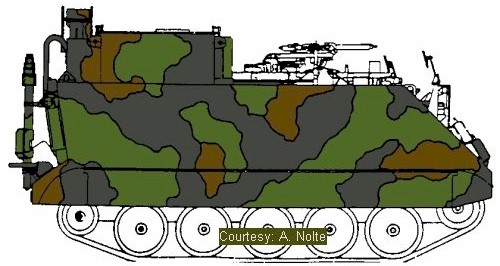 |
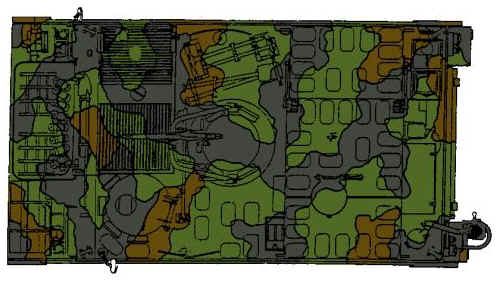 |
M113 Trägerfahrzeug RATAC ABRA (Artillerie Beobachtungs Radar Anlage)
.jpg) |
At the end of the 50s, the M113 of the U.S. Army was commissioned and 1600 were introduced into theBundeswher in 1962
The M113 is made of light metal All hatches and doors are sealed against water. Originally buoyant, the M113 after update lost the buoyancy .
In 1963/64, some M113 receive new equipments including a new crawler, German lighting system, new radio equipment, fog means plant litter and German inscriptions on / in the vehicle. With this upgrade, the M113,wascalled M113 G.
In 1974-1981, the M113 were gradually converted to diesel and receive the designation M113 A1 GE.
In the 80s, some with diesel engines were converted with a Saugkühlanlage ( increased cooling or under pressure in the engine ) with the result of exhaust fumes in the crew room
Other small improvements, these vehicles, the designation M113 A2 GE. In addition at the end of the 80s with some vehicles receive an external fuel tank (EFT) with a volume of 360 liters to enlarge the storage space has led the fight.
But with 12.5 tons the M 113 was dangerous to drive (defects of the driving and braking unit )
They were upgraded with an improved steering and braking system, a new MTU diesel engine with 300 horsepower and a new chain .
These versions receive the designation of M113 G3 EFT GE.
The vehicle Ratac ABRA (Artillerie Beobachtungs Radar Anlage or artillery observation radar) is used for calibration of enemy artillery positions, and the battlefield surveillance and management of vehicles and Lfz on the battlefield. From 1976 to 1978, Bundeswher receive 62 vehicles with the Ratac system. This system has a 6m long telescopic mast and the radar has a range of 20km. for vehicles, for persons 12 km and for the projectiles caliber 105 mm and 155 mm 12 or 18 km. The observation data obtained using the tube artillery to their steep insertion firearms and to monitor the shooting effect. The deployment takes place at the artillery observation battalions, The weight of the vehicle is 13 tons and has an operating area of approximately 300km.